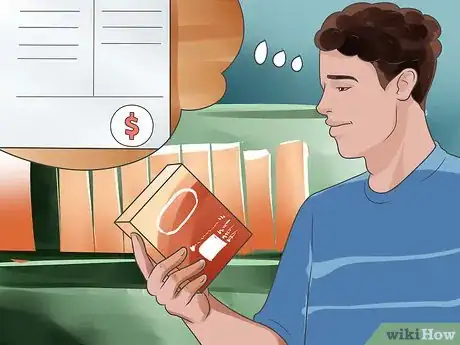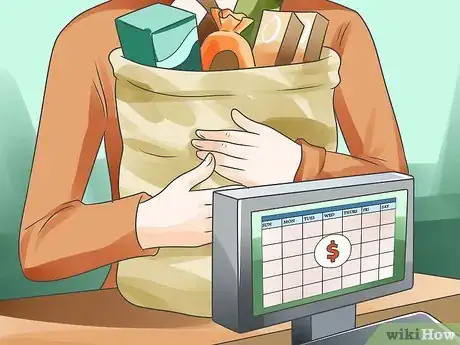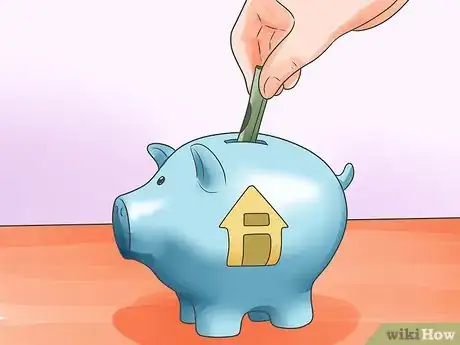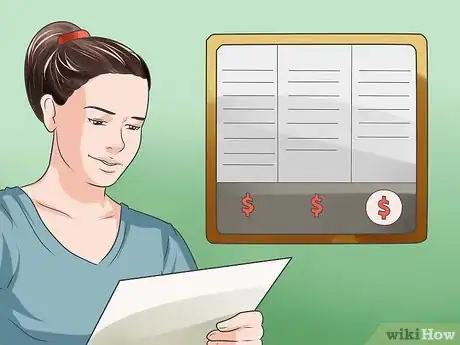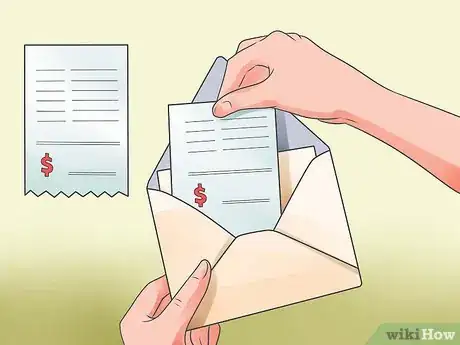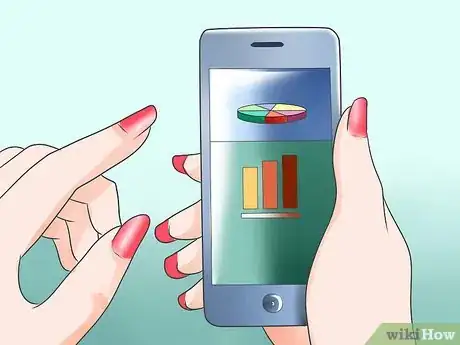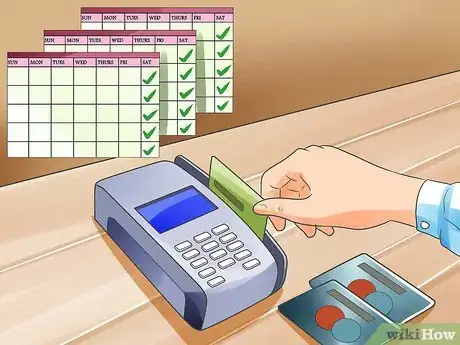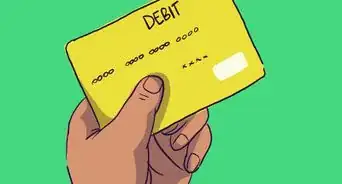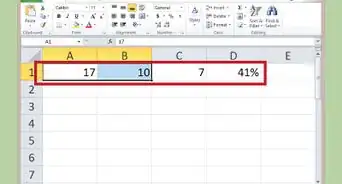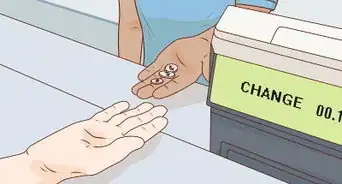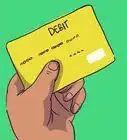This article was co-authored by Trent Larsen, CFP®. Trent Larsen is a Certified Financial Planner™ (CFP®) for Insight Wealth Strategies in the Bay Area, California. With over five years of experience, Trent specializes in financial planning and wealth management as well as personalized retirement, tax, and investment planning. Trent holds a BS in Economics from California State University, Chico. He has successfully passed his Series 7 and 66 registrations and holds his CA Life and Health Insurance license and CFP® certification.
There are 15 references cited in this article, which can be found at the bottom of the page.
wikiHow marks an article as reader-approved once it receives enough positive feedback. This article received 11 testimonials and 91% of readers who voted found it helpful, earning it our reader-approved status.
This article has been viewed 449,940 times.
Do you find yourself spending your paycheck or your allowance as soon as you get it? Once you start spending, it can be difficult to stop. But overspending can lead to piles of debt and zero savings. Stopping yourself from spending money can be difficult, but with the right approach, it's possible to stop spending money and save it instead.
Steps
Adjusting Your Spending Habits
-
1Create a budget and stick to it. Determine what your basic expenses will add up to every month to make sure you don't spend money you don't have.[1] These likely include:[2]
- Rent and utilities. Depending on your living situation, you may be splitting these expenses with a roommate or a partner.[3] Your landlord may also pay for your heat, or you may pay for your electricity every month.
- Transportation. Are you walking to work every day? Biking? Taking the bus? Carpooling?
- Food. Factor the average amount per a week for meals for the month.
- Health care. It is important you have health insurance in the event of an incident or accident, as paying out of pocket will likely be more expensive than being covered. Do some research online to find the best insurance rates.
- Miscellaneous expenses. If you have a pet, this could be where you determine how much pet food will be for the month. If you and your partner go for a date night once a month, factor this in as an expense. Account for every expense you can think of so you do not spend money without knowing exactly where it is going.
- If you have any debt payments, add these to your budget under necessary expenses.
-
2Go shopping with a goal in mind. A goal could be: new socks to replace your holey pairs. Or, replacing your broken cellphone. Having a goal when shopping, especially for discretionary items, will stop you from spontaneous purchases. Focuses on one essential item when shopping also gives you a clear budget for your shopping trip.[4]
- When food shopping, look at recipes beforehand and make a grocery list. This way, when you are in the store, you can stick to the list and know exactly how you are going to use every ingredient you buy.
- If you have a hard time sticking to a grocery list, try online grocery shopping. This will allow you to keep a running total of your purchases and be aware of exactly what you are spending.[5]
Advertisement -
3Don't get sucked into sales. Ah, the irresistible lure of a deal! Retailers are counting on their customers to get sucked in by the sales rack. It's important to resist the temptation to justify a buy just because its on sale. Even big discounts can mean big spending. Instead, your only two considerations when shopping should be: do I need this item? And does this item fit within my budget?[6]
- If the answer is no to these questions, it may be best to leave the item in the store and save your money on an item you need, rather than want, even if its on sale.
-
4Leave your credit cards at home.[7] Only take the cash you need, based on your budget, to get through the week.[8] That way, you will have to walk away from an unnecessary purchase if you have already spent all your cash.[9]
- If you do end up taking your credit card with you, treat it like a debit card. This way, every cent you spend on your credit card feels like money will have to pay back every month. Treating your credit card like a debit card means you won't be so hasty to whip it out for every purchase.
-
5Eat at home and bring your lunch. Eating out can get very expensive, especially if you're spending $10-$15 a day, 3-4 times a week. Limit your eating out to once a week and then gradually, to once a month. You should notice how much money you save when you buy groceries and cook for yourself. You will also appreciate a nice meal out for a special occasion that much more.[10]
- Bring your lunch to work every day, rather than shell out money for lunch. Take 10 minutes at night before bed or in the morning before work to make a sandwich and a snack. You will notice you save quite a bit of money every week by just bringing your lunch.
- Eat out sensibly. There is nothing wrong with buying lunch once in a while. But be aware of choices that are good deals. Check for lunch specials. Look for coupons. Try buying lunch at the grocery store rather than the chic cafe.
-
6Do a Spending Fast. Test your spending habits by only buying what you need for 30 days or one month. See how little you can spend in one month by focusing on buying things you need, rather than things you want.[11]
- This will help you determine what you consider a necessity and what you consider a nice to have. Beyond the obvious necessities like rent and food, you may reason that a gym membership is a need because it keeps you fit and feeling good. Or a weekly massage to help with your bad back. As long as these needs fit within your budget and you can afford them, you can spend money on them.
-
7Go DIY. DIY or Do It Yourself is a great way to learn new skills and save money. There are many DIY blogs and books out that allow you to recreate expensive items with a limited budget. Rather than spend money on an expensive piece of art or a decorative item, make it yourself. This will allow you to create a custom item and stay within your budget.[12]
- Websites like Pinterest, ispydiy,[13] and A Beautiful Mess[14] all have great DIY ideas for household items. You can also learn how to recycle items you already own and make something new with them, rather than spend money on a new item.
- Try doing household chores and activities yourself. Shovel your walkway yourself, instead of paying someone else to do it. Get the whole family involved in outdoor chores, like mowing the lawn or cleaning the pool.
- Make your own household cleaning items and beauty products. Most of these products are made of basic items you can buy at your local grocery store or health food store. Laundry detergent, all purpose cleaner, and even soap can all be made by hand, by you, for cheaper than store prices.[15]
-
8Put money aside for a life goal. Work towards a life goal, like traveling to South America or buying a home, by putting aside a set amount of money in your savings account every month. Remind yourself that the money you save by not buying clothing or going out every week will go to a bigger life goal.
Assessing Your Spending Habits
-
1What non-essentials are you spending a lot on? When you are not living within your means, the first thing to examine are things that you do not really need.[16] [17] Unlike fixed expenses (essentials like rent, utilities, and other payments) which remain the same each month, discretionary expenses are nonessential and are easier to cut back on.[18]
- Ask yourself: Am I spending too much money on these discretionary expenses? Are you finding it difficult to pay bills because of going on vacation, for instance? Or do you really need the designer shoes or the latest gaming system?
- Check for things you do not use.[19] This may mean a gaming site subscription you have not used in months, or a gym you do not go to, or cancelling cable because you watch everything online.
- There are admittedly a few grey areas, such as a gym membership or a nice wardrobe that may be necessary for your professional career. These may not need cutting, but worth scrutinizing.
-
2Review your spending for the past quarter (three-month period). Look at your credit card and bank statements as well as cash expenditures to see where your money goes. Take note of even little things like a coffee, a postage stamp, or a meal on the go.[20]
- You may be surprised by how much you end up spending in just one week or in one month.
- If possible, look at data compiled over the course of a year. Most financial planners would review entire year of expenditures before making recommendations.
- Discretionary expenses can end up taking up a large percentage of your pay cheque or allowance. Recording them will give you a sense of where you can cut back on your spending.
- Take note of how much you spend on wants versus needs (for example, drinks at a bar versus groceries for the week).
- Figure out what percentage of your expenses are fixed versus discretionary. Fixed expenses remain the same each month, while discretionary expenses are malleable.
-
3Keep your receipts. This is a good way to track how much you spend on certain things every day. Rather than toss your receipts, keep them so you can record exactly how much you spent on an item or a meal. This way, if you end up overspending for the month, you can pinpoint exactly when and where you spent your money.
- Try to use less cash and instead use your credit or debit card, which can be tracked. Credit card balances should be paid in full each month if possible.
-
4Use a budget planner to assess your spending. A budget planner is a program that calculates how much your expenses are for a year and how much your income will be for a year. It will then tell you how much you can afford to spend in a given year, based on your expenses.[21]
- Ask yourself: Do I spend more than I earn? If you are dipping into your savings to pay for your rent every month or using your credit card to pay for shopping sprees every month, you are spending more than you earn. This can only lead to greater debt and less savings. So, be honest about your spending every month and make sure you only spend as much as you earn. This means factoring in money every month for expenses and savings.[22]
- You can also use budget apps to help track your spending on a day-to-day basis. Download a budget app to your phone and record your purchases right after you make them.[23]
Getting Help
-
1Understand the characteristics of compulsive shopping. Compulsive shoppers often cannot control their spending habits and become emotional spenders. They "shop till they drop" and then they keep shopping. But compulsive shopping and spending generally makes a person feel worse, rather than better, about themselves.[24]
- Compulsive shopping usually affects women more than men. Women with compulsive shopping issues usually have racks of clothing with the tags still on them. They will go to the mall with the intention of buying just one item and come home with bags of clothing.
- Compulsive shopping can be a seasonal balm for depression, anxiety, and loneliness during the holiday season. It can also occur when a person feels depressed, lonely and angry.
-
2Recognize the signs of compulsive shopping. Do you go on weekly shopping sprees? Do you continually spend more than you can afford?[25]
- Do you get a certain rush when you go shopping and buying things you don't need? You may feel a certain "high" when buying many things on a weekly basis.
- Notice if you have large amounts of debt on your credit card or multiple credit cards.
- You may also hide your purchases from concerned family members or partners. Or you may try to cover up your spending by taking on a part-time job to supplement your spending habits.
- Individuals who have a compulsive spending problem will likely be in denial and have a hard time admitting they have a problem.
-
3Talk to a therapist. Compulsive shopping is considered an addiction. So talking to a professional therapist or going into a support group for compulsive shoppers are both important ways you can address the issue and work to resolve it.
- During therapy, you may identify the underlying issues behind your compulsive spending and acknowledge the dangers of over spending. Therapy can also offer healthy alternative ways to cope with your emotional issues.
Expert Q&A
Did you know you can get expert answers for this article?
Unlock expert answers by supporting wikiHow
-
QuestionHow do you break the habit of spending money?
 Benjamin PackardBenjamin Packard is a Financial Advisor and Founder of Lula Financial based in Oakland, California. Benjamin does financial planning for people who hate financial planning. He helps his clients plan for retirement, pay down their debt and buy a house. He earned a BA in Legal Studies from the University of California, Santa Cruz in 2005 and a Master of Business Administration (MBA) from the California State University Northridge College of Business in 2010.
Benjamin PackardBenjamin Packard is a Financial Advisor and Founder of Lula Financial based in Oakland, California. Benjamin does financial planning for people who hate financial planning. He helps his clients plan for retirement, pay down their debt and buy a house. He earned a BA in Legal Studies from the University of California, Santa Cruz in 2005 and a Master of Business Administration (MBA) from the California State University Northridge College of Business in 2010.
Financial Advisor Saving money is all about small, incremental steps that can make a big impact. For example, let's say you regularly eat out with friends. Is it the expensive steak that makes the evening so special or is it just being with friends that makes it special? If you're a total foodie and you love food, then by all means, spend money on food. If you just want to hang out with your friends, and you think you can have just as much fun over a burrito, buy the burrito instead or cook your meals.
Saving money is all about small, incremental steps that can make a big impact. For example, let's say you regularly eat out with friends. Is it the expensive steak that makes the evening so special or is it just being with friends that makes it special? If you're a total foodie and you love food, then by all means, spend money on food. If you just want to hang out with your friends, and you think you can have just as much fun over a burrito, buy the burrito instead or cook your meals. -
QuestionWhat is intentional spending?
 Benjamin PackardBenjamin Packard is a Financial Advisor and Founder of Lula Financial based in Oakland, California. Benjamin does financial planning for people who hate financial planning. He helps his clients plan for retirement, pay down their debt and buy a house. He earned a BA in Legal Studies from the University of California, Santa Cruz in 2005 and a Master of Business Administration (MBA) from the California State University Northridge College of Business in 2010.
Benjamin PackardBenjamin Packard is a Financial Advisor and Founder of Lula Financial based in Oakland, California. Benjamin does financial planning for people who hate financial planning. He helps his clients plan for retirement, pay down their debt and buy a house. He earned a BA in Legal Studies from the University of California, Santa Cruz in 2005 and a Master of Business Administration (MBA) from the California State University Northridge College of Business in 2010.
Financial Advisor
References
- ↑ Trent Larsen, CFP®. Certified Financial Planner. Expert Interview. 22 July 2020.
- ↑ https://www.wikihow.com/Budget-Your-Money
- ↑ Trent Larsen, CFP®. Certified Financial Planner. Expert Interview. 22 July 2020.
- ↑ https://www.moneysavingexpert.com/family/stop-spending-budgeting-tool/
- ↑ https://www.moneysavingexpert.com/family/stop-spending-budgeting-tool/
- ↑ http://www.realsimple.com/work-life/money/spending/how-to-stop-spending-money/buy-items-on-sale
- ↑ Benjamin Packard. Financial Advisor. Expert Interview. 11 March 2020.
- ↑ Trent Larsen, CFP®. Certified Financial Planner. Expert Interview. 22 July 2020.
- ↑ https://www.moneysavingexpert.com/family/stop-spending-budgeting-tool/
- ↑ http://www.huffingtonpost.ca/2014/01/22/saving-money-tips_n_4646686.html
- ↑ http://www.mysimplerlife.com/spending-fast
- ↑ http://www.huffingtonpost.ca/2014/01/22/saving-money-tips_n_4646686.html
- ↑ http://ispydiy.com/blog/
- ↑ http://www.abeautifulmess.com/diy/
- ↑ http://www.everydaycheapskate.com/
- ↑ Benjamin Packard. Financial Advisor. Expert Interview. 11 March 2020.
- ↑ Trent Larsen, CFP®. Certified Financial Planner. Expert Interview. 22 July 2020.
- ↑ http://www.bankrate.com/finance/personal-finance/spending-too-much-try-the-7-day-challenge-2.aspx
- ↑ Benjamin Packard. Financial Advisor. Expert Interview. 11 March 2020.
- ↑ http://www.bankrate.com/finance/personal-finance/spending-too-much-try-the-7-day-challenge-2.aspx
- ↑ http://www.moneysavingexpert.com/banking/Budget-planning
- ↑ Trent Larsen, CFP®. Certified Financial Planner. Expert Interview. 22 July 2020.
- ↑ http://www.tomsguide.com/us/pictures-story/548-best-budget-expense-apps.html
- ↑ http://www.indiana.edu/~engs/hints/shop.html
- ↑ hhttp://www.indiana.edu/~engs/hints/shop.html
About This Article
To stop spending too much money, create a budget by adding up your monthly expenses, like rent and food, and look for any non-essentials you might be spending too much money on, like shopping or coffee. Additionally, resist overspending by asking yourself questions like “Do I need this?” and “Does this fit within my budget?” and only buy something if you can answer “Yes” to both questions. For tips on how to stop overspending from our Financial reviewer, including how to save money with DIY blogs like Pinterest, keep reading!


